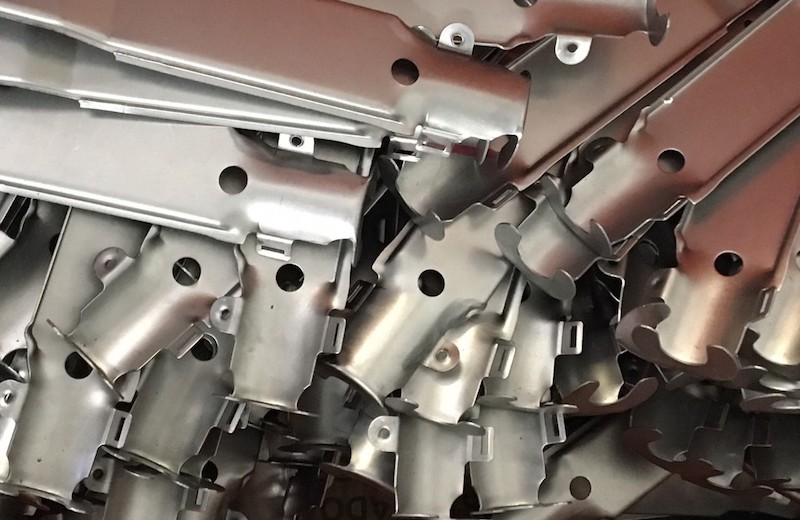Why Metal Stamping is Essential for Creating Resilient and Complicated Parts
Wiki Article
The Development of Metal Marking Procedures: Developments and Applications
The world of metal marking procedures has witnessed a transformative journey marked by continuous innovation and adjustment to fulfill the demands of contemporary commercial techniques. From the standard techniques deeply rooted in background to the cutting-edge technologies driving high-speed accuracy, the development of steel marking has been nothing brief of exceptional. As new tooling techniques and automation locate their way right into this sector, the ramifications for performance and top quality are profound. The applications cover across a range of sectors, each benefiting uniquely from the developments in steel stamping processes.Standard Steel Stamping Techniques
Traditional metal stamping strategies have actually long been the foundation of manufacturing procedures in various sectors due to their efficiency and accuracy. The process includes developing a steel sheet or coil right into a wanted form by pushing it between a die and a strike. This technique is extensively made use of for creating huge quantities of get rid of high precision at a quick pace.One of the essential benefits of conventional steel stamping strategies is the ability to keep limited tolerances, making certain that each component satisfies the needed requirements regularly. This level of accuracy is vital in industries such as automobile, aerospace, and electronic devices, where even minor variances can cause significant problems.
Additionally, traditional steel stamping methods provide affordable remedies for mass manufacturing contrasted to other producing techniques. The ability to stamp components in fast succession lessens manufacturing time and lowers labor prices, making it an attractive choice for businesses aiming to enhance their manufacturing procedures.
Introduction of High-Speed Stamping

One of the crucial advantages of high-speed stamping is its capacity to maintain accuracy and uniformity also at accelerated processing speeds. This accuracy is essential in markets where limited tolerances and complex styles are needed. Additionally, high-speed marking enables the handling of a wide variety of products, consisting of light weight aluminum, stainless-steel, and copper, more expanding its applicability throughout different sectors.
In addition, the introduction of high-speed marking has enabled producers to satisfy the growing need for complicated components in industries such as automobile, aerospace, and electronic devices (Metal Stamping). By leveraging the speed and accuracy of high-speed stamping innovation, companies can boost their competitiveness in a quickly evolving market landscape
Developments in Tooling Modern Technology
With the evolution of high-speed stamping making it possible for improved precision and efficiency in metal forming procedures, the area of metal stamping has seen significant improvements in tooling modern technology. Tooling modern technology plays a vital duty in steel stamping procedures, influencing factors such as item quality, production speed, and total cost-effectiveness. One crucial innovation in tooling modern technology is the advancement of intelligent tooling systems that include sensing units and keeping track of devices to offer real-time information on the stamping process. These systems can identify problems look these up such as tool wear or imbalance, enabling instant changes to maintain optimal efficiency.By utilizing these innovative products, tooling suppliers can generate dies and mold and mildews that stand up to the high stress and temperature levels entailed in metal stamping processes, resulting in longer device life and better manufacturing efficiency. In general, these advancements in tooling technology have reinvented the metal stamping industry, enabling manufacturers to accomplish greater levels of precision, productivity, and cost savings.
Combination of Automation in Stamping
As automation remains to improve the landscape of metal stamping procedures, the assimilation of automated systems has come to be increasingly prevalent in contemporary production facilities. Automated systems provide numerous advantages in steel stamping, including increased performance, boosted accuracy, and boosted security. By incorporating automation right into stamping procedures, manufacturers can lower cycle times, reduce material waste, and optimize manufacturing throughput.
One of the essential parts of automation in marking is the usage of robot arms for jobs such as product handling, part manipulation, and quality evaluation (Metal Stamping). These you can try this out robotic systems can carry out repeated and labor-intensive jobs with rate and accuracy, freeing up human drivers to concentrate on even more intricate procedures. In addition, automation enables for real-time tracking and adjustment of stamping procedures, leading to greater overall procedure control and high quality guarantee
Moreover, the assimilation of automation in stamping enables producers to achieve consistent part top quality, fulfill tight tolerances, and enhance total performance. As technology continues to breakthrough, the duty of automation in steel marking processes is expected to broaden even more, driving innovation and performance in the manufacturing industry.
Applications Throughout Diverse Industries
Integrating metal marking procedures across diverse sectors showcases the adaptability you could try these out and versatility of this manufacturing technique. In addition, the home appliance sector advantages from metal stamping procedures to manufacture components for refrigerators, washing equipments, and other home appliances. The flexibility of metal marking processes makes it a valuable production technique throughout various sectors, demonstrating its importance in modern-day production procedures.Conclusion

Report this wiki page